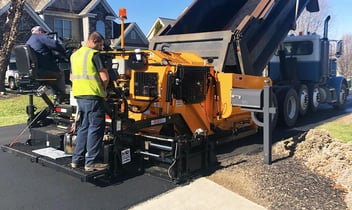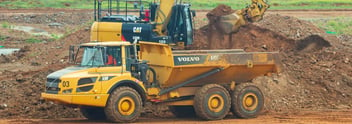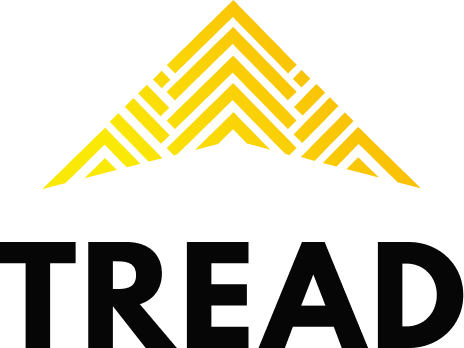Construction Equipment Maintenance: Why It Matters
Owning and operating a construction company is not without its challenges, the biggest of which is operating and maintaining a fleet of high-value heavy machinery. Not only can the cost of equipment go well into the millions, but the price of repairing or replacing faulty machines and the subsequent toll this can take on company expenses can be staggering.
That’s why construction equipment maintenance is so important.
If you own or manage a construction company with a fleet of heavy machinery, we’ve put together ten strategies for creating and managing an effective equipment maintenance program so you can protect your investments and your company’s bottom line.
What is construction equipment maintenance?
Construction equipment maintenance is a proactive, scheduled approach to equipment repair, rather than a reactive, unscheduled, post-breakdown approach. As the saying goes in the construction world, “a dime of routine and preventive maintenance is worth a dollar in repairs.” This means taking proactive measures to prevent machine failure from the get-go is much more cost-effective than reactively repairing machines. There are two main types of construction equipment maintenance: routine maintenance and preventive maintenance. Both go hand in hand to prolong the longevity of your equipment and keep operations running smoothly, with a few differences.
Routine maintenance
Routine equipment maintenance is done on a scheduled and ongoing basis on each machine. These maintenance tasks are usually straightforward service work that can be done by machine operators and do not require highly specialized skills.
Routine maintenance can include:
- Lubricating machinery
- Oil changes or filter changes
- Safety inspections
- Replacing deteriorating parts
- Tire inspections
- Pressure tests
- Checking transmission fluid levels
- Checking engine coolant levels
- Checking the parking brake
Preventive maintenance
Preventive maintenance is a little more robust than routine maintenance, taking a big picture approach. Service technicians look for problems in the making, performing maintenance while the equipment is still working to avoid unexpected breakdowns.
Preventive maintenance can be time-based (scheduled inspections) or usage-based (every 10,000 km). As you can tell, preventive maintenance is more costly than routine maintenance, which is why it is also important to strategically choose which equipment to routinely maintain and which can benefit from preventive maintenance.
If your construction equipment serves a critical function to business operations or the probability of a break-down increases with prolonged time or usage, you may want to consider a preventive maintenance program for them.
Why is construction equipment maintenance important?
The importance of preventive maintenance is vital, not only to prevent unexpected heavy equipment failure, but for the additional reasons below.
1. Cost savings
Lowering expenses is generally at the top of the list of business goals for most construction companies. According to a University of Nebraska study, improving preventive maintenance procedures can reduce heavy machinery repair costs by up to 25%. Let’s put that in concrete dollar amounts. With average maintenance, an $80,000 dump truck will cost $24,000 in repairs within 5000 hours of operation. With proper preventive maintenance, those repair costs could be reduced to $18,000—a whopping $6,000 in savings.
2. Predictable expenses
Properly functioning machinery for a longer period of time also means fewer unexpected breakdowns, repair costs, and downtime, resulting in lost revenue for the company.
Poorly maintained machines are also known to cause compound failures. One small problem can lead to another, and another, until before you know it, you’re up to your eyeballs in costly repairs that could have been avoided with preventive maintenance.
Not only that, if equipment has been well maintained throughout its lifetime, it will have a higher resale or trade-in value saving you money even at the end of its lifetime.
3. Improve the longevity of equipment
This is one of the most important reasons to perform preventive maintenance on your heavy equipment. It goes without saying—equipment that is properly maintained will last longer and work better than equipment that is rarely maintained. Preventive maintenance increases equipment life cycle, saving you the hassle and cost of replacements or disposals.
4. Safety
Equipment that is well maintained is also safer and more reliable than poorly maintained equipment. The last thing you want as a business owner is a sudden component failure—this is a huge environmental hazard that could seriously injure not only its operator, but anyone in close proximity and could even cause damage to other equipment. Sudden failure is a costly consequence, not only for the health of your workers, but for your high investment equipment.
5. Improved efficiency
This refers to efficiency from both a business and service perspective. When heavy equipment fails, there is no choice but to pull it from service for repairs. This means a paid machine operator is now idly waiting while equipment is in the shop, or being assigned small, menial tasks. On top of that, if the machine is critical to business operations and supports other machinery, its downtime can affect company efficiency as operations may fall behind schedule.
How to prepare an effective construction equipment maintenance program
In order to reap the benefits above, you must establish a construction equipment maintenance program.
Creating a routine preventive maintenance program is not difficult—in fact, the biggest hurdle to overcome is getting workers to commit to it. And the best way to do that is to lead by example. Once a team notices a company taking its equipment maintenance plan seriously, they’ll naturally follow suit.
1. Determine what the construction equipment maintenance program will cover
There are three main components to an effective maintenance program
- Listing out all the routine and preventive maintenance each machinery requires
- Assigning inspections—this will depend on heavy machinery in your fleet and each service technician’s experience
- Replace worn parts and make adjustments as necessary to prevent future breakdowns
2. Determine who will be responsible for carrying out the program
Depending on company size, this could be the owner, fleet manager, head service technician, or similar —someone who is in a leadership position who can also take care of administrative tasks is ideal.
3. Create an equipment maintenance schedule
Part of an effective construction equipment maintenance program is adhering to a regular maintenance schedule. The maintenance intervals could be decided upon in a variety of ways such as:
- According to machine operating hours (every 5,000 hours)
- Length of time (every four weeks)
- Distance traveled (every 10,000 km)
- According to local climate concerns (rainy season, humidity, snow, temperature fluctuations)
Choosing the right maintenance schedule will depend on the specific machine and equipment manufacturer guidelines. Sticking to maintenance schedules will also allow technicians to anticipate maintenance tasks and to plan their work accordingly.
4. Keep maintenance records
Keeping detailed records is a key component of construction equipment management. A robust maintenance plan is futile unless data is kept for each machine’s service history. Regular maintenance should be recorded in writing either in a hard copy ledger or electronically, organized by type of machinery. This documentation should include the date, type of service performed, any irregularities noticed, any parts that were replaced, and details for the next service.
Keeping these detailed records will help you keep track of all the services performed on all your machinery, give you a clear picture of the equipment’s history, and help you draw patterns to determine which machinery is providing the most or least Return on Investment.
Documentation is also important should a machine break down and should you need to make a warranty claim. For example, if the equipment manufacturer makes a claim for equipment neglect, these records can be used as clear proof of regular servicing.
5. Create an equipment maintenance checklist
Having an equipment maintenance checklist on hand will ensure that no stone is left unturned, and helps you keep those responsible for leading the preventive maintenance program accountable. Not sure where to begin? We’ve put together this heavy equipment maintenance checklist, with maintenance tips broken down according to checks performed daily vs. operating hours.
6. Get your operators and technicians involved
The advice and opinions of your equipment operators is invaluable, as they are the ones who work with the equipment on the ground on a daily basis. Working with the same equipment everyday, your operators most likely have a “feel” for the equipment in a way that an outsider wouldn’t.
Take advantage of their knowledge and experience, and empower them to make proactive decisions to bring any potential issues they spot to the attention of higher management and to take care of them before they become total machine failures. If a machine operator has the expertise to perform routine maintenance checks, give them the responsibility to do so, as they will most likely know best what to look for and know when issues are developing. Let your machine operators and service technicians work together as a team to discuss and identify problems to avoid unexpected repairs.
7. Know what causes equipment failure
While organizing maintenance schedules and making checklists takes some administrative know-how, committed maintenance program administrators should also know their equipment and what makes their machines tick. Knowing the types of equipment failure is a key component to leading a successful maintenance program, so that you can also help your team in identifying and solving equipment problems.
Sudden failure
This is when heavy equipment breaks down suddenly and unexpectedly, and is the most damaging of all types of equipment failure. Usually, there is no contingency plan for the equipment’s downtime, and the construction equipment must be pulled from service until it is repaired. Sudden failure repairs usually cost the most out of all failure types, due to unexpected expenses like mechanic fees and ordering parts. These breakdowns usually happen because a component has worn out, and is preventable during routine and preventive maintenance inspections.
Intermittent failure
This is not a total breakdown, but sporadic issues that inexperienced operators may not even notice. Usually, this manifests as sputtering or temporary stalling. If the operator is experienced, they will notice the intermittent failure and take steps to correct the problem. Otherwise, if neglected, intermittent failures could eventually lead to sudden failures. Intermittent failure is also preventable by routine and preventive maintenance.
Gradual failure
Gradual failure happens over time, and is usually due to regular equipment wear and tear. The good news is that gradual failures are slow to onset and can be easily remedied by routine and preventive maintenance. If neglected, gradual failure could eventually lead to intermittent failure.
In addition to the three types of failures, there are also a few key reasons for construction equipment failure, which are identifiable and preventive with proper maintenance plans.
Thermally induced failure
This construction equipment failure happens due to changes in temperature like extreme heat or extreme cold—both of which push equipment to their limits, resulting in a sudden stress failure. Thermally induced failures can be prevented by knowing the equipment’s temperature limits, and preparing for changes in temperature.
Mechanically induced failure
Mechanically induced failure is just what it sounds like—failure that happens to construction equipment when a component breaks or fails. This usually occurs due to lack of lubrication, equipment abuse, overexertion or collisions. Mechanically induced failures can also be prevented with routine and preventive maintenance and by ensuring parts are lubricated, fasteners are tightened, and moving parts are properly aligned.
Erratic failure
This one is the most difficult to predict and prevent, and happens suddenly under various conditions. Erratic failures to construction equipment can happen due to a variety of reasons like an electrical short, or sudden overloads. The challenge with erratic failures is that because they are so unexpected, it is difficult to prevent them. Regardless, erratic failures should always be reported and addressed immediately by technicians to avoid additional problems down the road.
8. Train employees
Operator training is a vital component of an effective equipment maintenance program. Well trained operators not only know how to properly use machinery to reduce wear on equipment, but will also know how to spot signs of potential damage, if a machine is in working order, or if it requires routine or preventive maintenance. While training operators is a time and resource investment at first, they will be imperative to protecting your assets. Training should include verbal instruction as well as demonstration of systems and controls, including pre and post operation maintenance tasks. Providing operators with a checklist is also a good idea to ensure no service tasks have been missed.
9. Review original manufacturer manuals
As previously mentioned, knowing your construction equipment inside and out, and thorough product knowledge is key to a good routine and preventive maintenance program. Equipment manufacturers provide detailed manuals with maintenance tips and suggested maintenance schedules for construction companies. Do your due diligence and be sure to review these manuals when establishing a preventive maintenance program.
10. Use maintenance service providers
It can be difficult to manually track things like operating hours, distance traveled, and other equipment data manually. That’s where driver management software like Tread.io, comes in. Using telematics data, Tread.io allows construction companies to easily manage their vehicles’ operating hours, miles travelled, and driver behavior to better manage equipment maintenance—without the need to install any hardware into your vehicles. All information is stored in the cloud and is paperless, so key stakeholders can access data easily.
Protect your heavy machinery investments
Construction equipment maintenance plays an important role in extending the life cycle of your machines. With these strategies, you can reduce the amount of repairs to your equipment as well as keep your equipment in top condition for longer.
Request a demo to learn more about how Tread.io can help improve your maintenance programs, lower costs, and increase business profits.
Read On

Ultimate heavy equipment maintenance checklist
For any construction company to be profitable, their heavy machinery must be well maintained and in...

Effective Construction Equipment Management Guide
Selecting the right equipment for a construction project is crucial when it comes to budget,...

Construction equipment management to reduce downtime
How much do downtime delays cost your company? If you use heavy construction equipment, unplanned...

